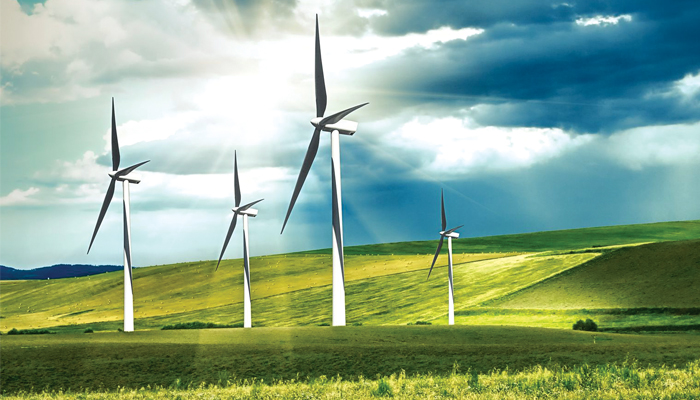All
Renewables Are Changing the Energy Mix
by Ed Burke, Dennis K. Burke Inc.

Wind and solar are getting less expensive, helping renewables experience a real growth spurt in installations during 2015. Overall, renewable energy did pretty well last year.
It was a record-breaking year for corporations like Amazon, Google, Microsoft and Walmart, who purchased large-scale wind and solar energy. These corporations signed roughly 3 GW of power purchase agreements for large-scale renewable energy last year, more than double the amount for 2014.
In December, Congress passed the tax extenders package that included a retroactive extension through 2016 of a $1 per gallon biodiesel blenders tax credit and a $1.01 per gallon production credit for cellulosic biofuels. Federal lawmakers also passed extensions and modifications of federal tax credits for new wind and solar projects.
And in Paris, more than 190 nations reached a historic accord to address climate change, committing nearly every country to lowering carbon pollution.
Liquid Biofuels
In November 2015, the U.S. Environmental Protection Agency (EPA) finalized the Renewable Fuel Standard (RFS) volumes for 2014 through 2016 and got things back on track. The largest effect of the proposed RFS targets will be on biodiesel consumption, which helps to meet the RFS targets for use of biomass-based diesel, advanced biofuel, and total renewable fuel.
U.S. consumers used about 2.09 billion gallons of biodiesel in 2015, up from about 1.97 billion gallons in 2014. Biodiesel production is forecast to increase 27 percent in 2016. The biodiesel industry has voiced concerns with the growing trend in which they say that imports are increasingly flooding the U.S. market and undercutting domestic production.
Ethanol consumption averaged 910,000 barrels per day in 2015, and it is forecast to average more than 920,000 barrels per day in both 2016 and 2017. At this level of consumption, the ethanol share of the total gasoline pool averages about 10 percent in both 2016 and 2017, avoiding the blend wall issue.
Wind and Solar
Total renewables used in the electric power sector are expected to increase about 8 percent in 2016.
Wind power accounted for about 4 percent of U.S. electric generation in 2015. Wind capacity, which starts with a much larger installed capacity base than solar, grew by 13 percent in 2015, and is expected to increase by 14 percent in 2016, and 3 percent in 2017.
Over the last 10 years, utility-scale wind energy capacity has grown by 67 percent, from less than 9 GW to nearly 70 GW. In part, the industry’s success has been driven by reductions in the cost of wind power. The rates for wind power purchase agreements have fallen from 7 cents per kWh in 2009, to 2 cents per kWh – a 71 percent drop.
These trends are prevalent all across the country. Utility-scale wind power is developed across 39 states, and in nine states, wind power exceeds 10 percent of the total in-state electricity generation.
Solar Photovoltaic (PV) technology has rapidly emerged as a mainstream technology over the past few years. Utility-scale solar PV system installations increased by about 50 percent last year, reaching a 10 GW milestone. Utility-scale systems are expected to increase by about 80 percent (10 GW) by the end of 2017.
Distributed generation PV systems (rooftop panels installed on homes and businesses) increased 28 percent in 2015. There are now over 80,000 distributed generation PV systems installed across the country. This is possible due to the dramatic decline in the price of solar PV systems – down 59 percent over the past six years.
Hydropower
In 2015, hydropower accounted for about 6 percent of U.S. electric generation, despite lower than normal water and snowpack levels. Hydropower generation in the power sector is expected to increase about 3.6 percent in 2016.
The Clean Power Plan
In August 2015, EPA signed the Clean Power Plan rule that would implement the first federal limits on carbon pollution from existing power plants, and drive a more aggressive transition to renewable energy. Right from the start, there was a lot of push-back from states that rely heavily on coal-mining and coal-fired electricity generation. The plan would cut heat-trapping carbon emissions from the power sector by close to a third from 2005 levels by 2030.
Last fall, more than two dozen states, along with industry groups, sued the EPA, arguing the agency exceeded its authority in implementing the regulation. In February 2016, the Supreme Court voted 5 to 4 to temporarily block the EPA Clean Power Plan as legal challenges move through federal appeals court.
Green Investments
The International Energy Agency estimates that about $4 trillion in renewable investments and about $8 trillion in energy efficiency investments will be made worldwide over the next 15 years.
Related Posts
 Why Quality Matters in Your Biofuel Blends
Why Quality Matters in Your Biofuel Blends
Posted on June 25, 2025
 HEAT Show Gears Up
HEAT Show Gears Up
Posted on June 25, 2025
 What’s Next in Boiler Technology
What’s Next in Boiler Technology
Posted on June 25, 2025
 How Intelligent Are Your Integrated Customer Platforms?
How Intelligent Are Your Integrated Customer Platforms?
Posted on June 25, 2025
Enter your email to receive important news and article updates.
